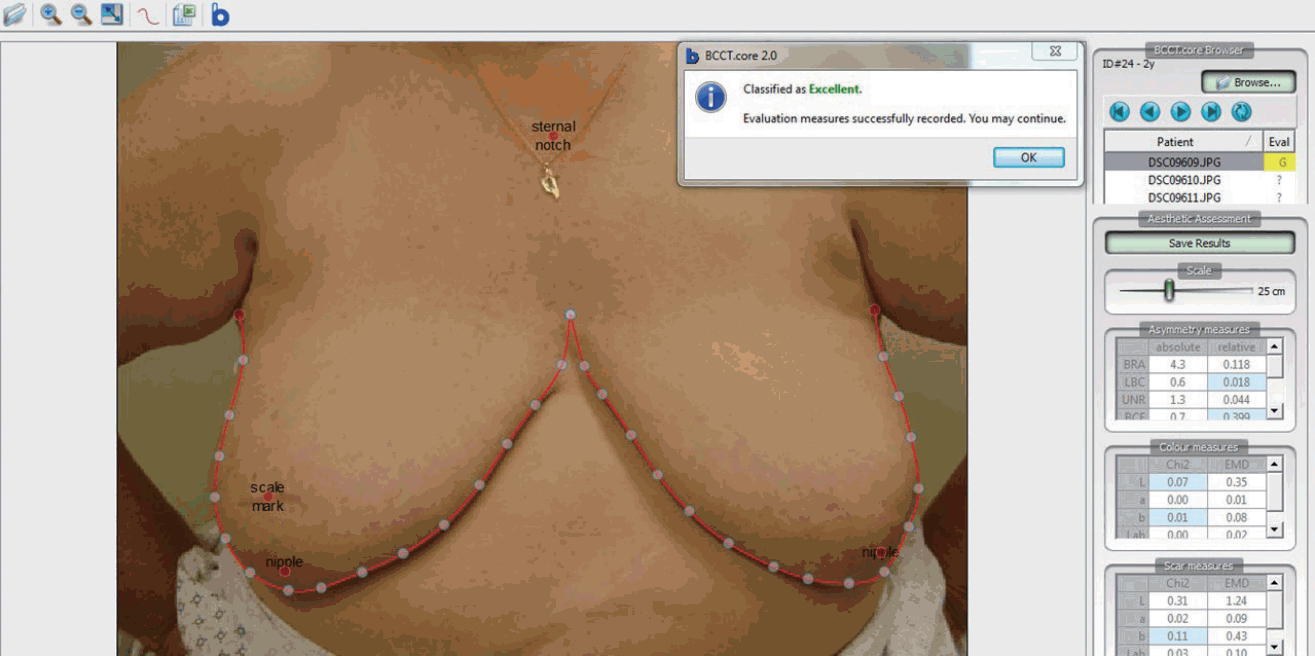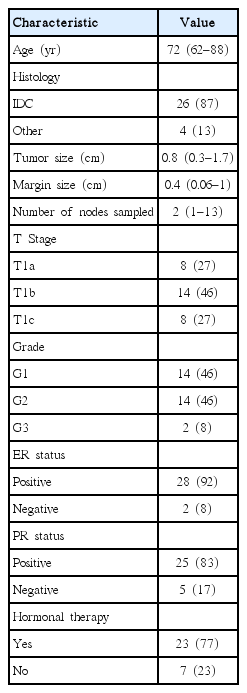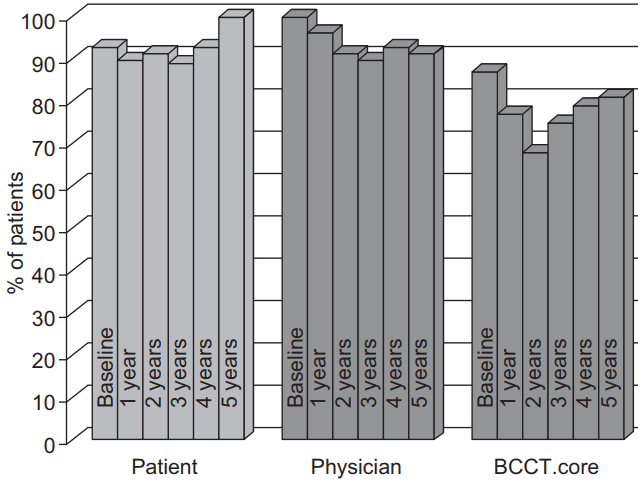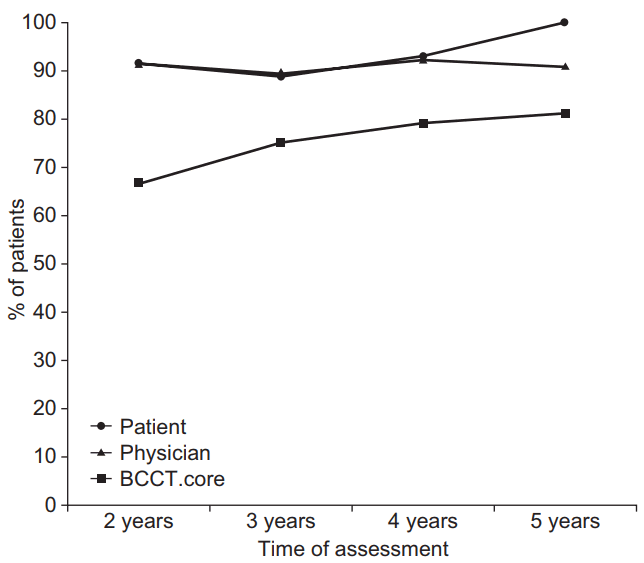Long-term cosmesis following a novel schedule of accelerated partial breast radiation in selected early stage breast cancer: result of a prospective clinical trial
Article information
Abstract
Purpose
There is controversy regarding the cosmetic outcome after accelerated partial breast radiation (APBR). We report the cosmetic outcome from a single-arm prospective clinical trial of APBR delivered using intensity-modulated radiation therapy (IMRT) in elderly patients with stage I breast cancer (BC), using a novel fractionation schedule.
Materials and Methods
Forty-two patients aged ≥65, with Stage I BC who underwent breast-conserving surgery were enrolled in a phase I/II study evaluating a 2-week course of APBR. Thirty eligible patients received 40 Gy in 4 Gy daily fractions. Cosmetic outcome was assessed subjectively by physician/patient and objectively by using a computer program (BCCT.core) before APBR, during, and after completion of the treatment.
Results
The median age was 72 years, the median tumor size was 0.8 cm, and the median follow-up was 50.5 months. The 5-year locoregional control in this cohort was 97% and overall survival 87%. At the last follow-up, patients and physicians rated cosmesis as ‘excellent’ or ‘good’ in 100% and 91 %, respectively. The BCCT.core program scored the cosmesis as ‘excellent’ or ‘good’ in 87% of the patients at baseline and 81% at the last follow-up. The median V50 (20 Gy) of the whole breast volume (WBV) was 37.2%, with the median WBV V100 (40 Gy) of 10.9%.
Conclusion
An excellent rate of tumor control was observed in this prospective trial. By using multiple assessment techniques, we are showing acceptable cosmesis, supporting the use of IMRT planned APBR with daily schedule in elderly patients with early stage BC.
Introduction
Breast-conserving surgery (BCS) and whole breast radiation (WBR) for women with early-stage breast cancer has become a standard of care as it shown to be equivalent to mastectomy for local control and survival. However, adjuvant WBR requires up to 6 weeks of daily radiation treatment, leading to underutilization of WBR by elderly patients and those who reside long distance from treatment facilities. Recently, accelerated partial breast radiation (APBR) has been proposed as an alternative to WBR for women with early-stage breast cancer as it reduces treatment time. While several investigators reported excellent local control among appropriately selected patients, the concern remains about long-term cosmetic outcome.
Several techniques for APBR have been reported including multicatheter brachytherapy [1], MammoSite brachytherapy [2] and external beam radiation therapy (EBRT) with three-dimensional conformal radiation therapy (3D-CRT) or intensity-modulated radiation therapy (IMRT) [3,4]. IMRT improves conformal dose coverage [5] and provides better normal tissue sparing compared to 3D-CRT [6,7]. It allows control of the dose in the untreated part of the breast which theoretically should improve the cosmesis. There are only a limited number of studies using IMRT, and results regarding the cosmesis using APBR are conflicting. Most of the reported schedules of APBR used twice a day schedule which may have impacted on the cosmesis as the normal breast tissue may not have adequate time to recover. Twice a day schedules are also difficult on patients particularly elderly and those travel long distance. Therefore we designed our trial of APBR using daily treatments.
Subjective evaluation by the physicians and/or patient self-assessment is commonly used to report cosmesis [8]. Subjective evaluation by physicians has low reproducibility and self-assessment is more dependent on psycho-social adjustment than of the real cosmesis [9-11]. In order to overcome this issue, a computer program, BCCT.core, was developed to provide objective evaluation based on breast symmetry, skin color changes, and surgical scar appearance by using photographs of the patients taken during the follow-ups [12]. BCCT.core has been shown to assess the cosmesis accurately in multiple studies by providing consistent and reproducible results [13].
We previously reported excellent tumor control with acceptable toxicity [14]. We are reporting here cosmetic outcome and the dosimetric parameters. To our knowledge, this study is the first comprehensive investigation of cosmesis by using both subjective and objective evaluation with dosimetric assessment in patients treated with APBR.
Methods and Materials
1. Study population
Forty-two patients with stage I breast cancer were enrolled in this phase I/II study at University of Vermont Cancer Center between June 2006 and May 2013. The Institutional Review Board approved the study (IRB No. VCC-0601). The study was conducted in accordance with the principles of the Declaration of Helsinki and all patients provided written informed consent.
Eligibility criteria included: (1) ≥65 years old female patient with AJCC stage I breast cancer, post-partial mastectomy and axillary node dissection or sentinel lymph node biopsy; (2) visible lumpectomy cavity on planning computed tomography (CT); and (3) ability to begin radiation treatment 3–8 week post-surgery. If indicated, hormonal and chemotherapy was allowed. Patients with lymphovascular invasion (LVI) or positive tumor margins were not eligible. Only patients with photographs at baseline and from follow-up visits at ≥2 years were included in this analysis.
2. Simulation and treatment technique
Patients were simulated lying supine with both arms raised above the head on a breast board with Vacloc immobilization. Based on the planning CT scan, the lumpectomy cavity, both breasts, both lungs, and the heart were contoured. The clinical target volume (CTV) was defined as the excision cavity + 1.0 cm (5 mm from skin surface and from pectoralis muscle). The planning target volume (PTV) was a 0.5 cm expansion around the CTV. The final PTV was modified to exclude the first 5 mm of tissue from the skin surface and the portion extending into the lung.
IMRT was used for treatment planning using Philips Pinnacle planning system (Philips Healthcare, Best, The Netherlands). Planning guidelines were to cover the PTV with at least 95% isodose line. Ten fractions of 4 Gy were delivered once daily 5 days per week for a total dose of 40 Gy.
3. Dosimetric assessment
The whole breast volume (WBV) was individually outlined to include the glandular tangent fields. The volume of the whole breast receiving 5%, 20%, 50%, 80%, and 100% of the prescription dose (V5, V20, V50, V80, and V100) was recorded. Outside of the target breast volume (WBV–PTV) receiving the 5%–100% of the prescription dose (V5–V100) was determined. Maximum dose (Dmax), PTV, and PTV to WBV ratio was also assessed.
4. Patient follow-up
Patients were seen weekly while on treatment and for an additional 4 weeks by the treating radiation oncologist. Subsequent radiation oncology follow-ups were at 6 months, 1 year and yearly after for 5 years. Photographs were taken for cosmetic evaluation prior to radiotherapy and during subsequent follow-ups.
5. Cosmesis assessment
Cosmetic outcomes were assessed subjectively by the treating physician and the patient. The first cosmetic assessment was done at baseline prior to the start of radiation therapy, then at 6 months and yearly after for 5 years. The overall cosmetic assessment was done using the modified Harvard criteria for cosmesis [15] where a score of 9 or 10 (excellent) was given if the treated breast looks exactly the same as the opposite breast, 7–8 (good) minimal but identifiable effects of radiation; 4–6 (fair) significant effects of radiation on the breast; 1–3 (poor) severe normal tissue sequelae.
Objective cosmesis assessment was performed using BCCT. core software (developed by UNESC at Porto University, Portugal) (Fig. 1). By using the patients’ photograph, BCCT. core assesses cosmetic result based on breast symmetry, scar visibility, and skin color changes. The software categories the cosmetic appearance as excellent, good, fair, and poor.
6. Statistical analysis
Statistical analyses were performed with the SPSS statistical software package ver. 17.0 (SPSS Inc., Chicago, IL, USA). Descriptive statistics were compiled to characterize the patient populations.
Results
1. Patient characteristics and clinical outcome
Forty-two patients were enrolled in this study from June 2006 to May 2013. One patient withdrew from the study, another patient was determined not to be eligible, and 10 patients did not have photographs at ≥2 years follow-ups. The characteristics of the 30 patients included in the study are shown in Table 1. All patients had negative margins and all of them underwent axillary evaluation. The majority of the patients had estrogen receptor (ER) and progesterone receptor (PR) positive tumors. Use of adjuvant hormonal therapy was left to the discretion of treating medical oncologist. Adjuvant chemotherapy was not used in any of the patients.
The median follow-up time at the time of this analysis was 50.5 months. The 5-year locoregional control rate was 97.5%. One patient with BRCA2 mutation had a recurrence in the same quadrant 20 months after radiation. Her disease was initially stage pT1bpN0 poorly differentiated invasive ductal carcinoma (IDC), ER/PR positive, and HER2 negative and the recurrence of disease was stage pT1bpN0 moderately differentiated IDC, triple negative. At recurrence she was treated with bilateral total mastectomy. The 5-year overall survival rate was 90%. During the follow-up time period, 4 patients (10%) died of non-breast cancer related causes without evidence of local recurrence.
2. Dosimetric parameters
Dosimetric radiation treatment parameters are shown in Table 2. The median PTV was 165.8 mL (range, 63.6 to 828.9 mL) and median PTV/WBV was 13.9%. The median V50 (20 Gy) of the WBV was 37.5%, with the median WBV V100 (40 Gy) was 10%. The median V50 (20 Gy) of the WBV minus PTV was 28.3% and the median V100 (40 Gy) was 2%. Median Dmax was 42.6 Gy (range, 40.4 to 44.7 Gy).
3. Cosmetic outcomes
Overall, during the entire follow-up 89%–100% of patients scored their overall cosmetic result as ‘excellent’ or ‘good’ (Fig. 2). Similarly, treating physicians rated 89%–100% of patients’ cosmesis as ‘excellent’ or ‘good’. The BCCT.core program scored 68%–87% of the of patients’ cosmesis as ‘excellent’ or ‘good’. The BCCT.core program scored ‘excellent’ or ‘good’ cosmesis at the baseline in 87% of patients and at the 5-year follow-up in 81% of patients. BCCT.core always scored lower than either patient or physician. The 4%–6% of the patients rated their cosmetic outcome as ‘poor’. However, no ‘poor’ outcome was either scored by the BCCT.core program or reported by the physicians. There was not deterioration in the overall cosmetic score after 2 years (Fig. 3).
Discussion and Conclusion
We previously reported an excellent rate of tumor control and favorable toxicity profiles with daily 2 weeks course of APBR using IMRT [14]. In this study, we have shown the subjective and objective evaluation of cosmesis with dosimetric assessment. APBR is a convenient treatment option in selected patients as it decreases the duration of the treatment. However, because of the lack of randomized clinical trial data, cosmetic outcome with APBR remains controversial. In this prospective trial with a 50.5-month median follow-up, we demonstrated acceptable cosmesis by using both subjective and objective assessment methods. The unique aspects of our study include the objective evaluation of the cosmesis and daily fractionation scheme.
Subjective evaluation by the physicians and/or patient self-assessment is commonly used to report cosmesis. However the results from these methods are not reproducible, influenced by patient’s psycho-social adjustment, and not comparable with the cosmesis result of other studies. Objective evaluation of the cosmesis by using a computer program is preferable to eliminate confounders and also compare different study results. To the best to our knowledge, none of the prior studies with external beam APBR used an objective evaluation method to report cosmesis. Due to the limited studies using IMRT with APBR and no objective cosmetic evaluation, the controversy regarding the acceptable cosmesis remains unresolved. The cosmetic outcomes in our study can be related to the fractionation schedule or dosimetry due to IMRT planning.
Excellent or good cosmesis was reported in 73%–82% of patients treated with APBR using 3D-CRT with various fractionation schedule [16-19]. The first study evaluating the outcome of APBR using IMRT with deep inspiration breath hold reported from University of Michigan [4]. Patients in this study received 38.5 Gy in 3.85 Gy fractions given twice daily over 5 consecutive days. Seven out of 34 treated patients (22%) developed unacceptable cosmesis at a 2-year interim analysis, leading the study to close. Cosmesis was assessed by the physicians. A subsequent reports from the same group reported the continued decline in cosmesis in same cohort at a median follow-up of 5 years [20]. Another study of APBR using IMRT was reported from University of Miami [21]. In this study patient received 38 Gy in 3.8 Gy fractions given twice daily over consecutive days. Cosmesis was assessed by both the physicians and the patients. The ‘excellent’ or ‘good’ cosmesis was reported by 94% of the patients and by 97% of the physicians. These results are similar to the cosmetic outcome in our study.
The important differences between our study and the two previous reports using APBR with IMRT includes the objective assessment of the cosmesis and daily fractionation scheme (Table 3). On the last follow-up, 100% of the patients scored their overall cosmesis as ‘excellent’ or ‘good’ and the physicians rated 91% of the patients with ‘excellent’ or ‘good’ outcomes. BCCT.core program scored 81% of the patients with ‘excellent’ or ‘good’ outcomes. While the objective evaluation with BCCT.core program reports less ‘excellent’ or ‘good’ outcomes compared to patients self-assessment and physicians rating, the baseline cosmesis assessment with BCCT. core is similar with assessment at the last follow up, indicating that the cosmesis was not compromised with the treatment. Furthermore, unlike the reports from Liss et al. [20] and Lei et al. [22] there is no trend toward continued decline in cosmesis over time.
In this current study, patients received 40 Gy in 4 Gy daily fractions. The daily fractionation schedule logistically is easier for patients particularly elderly and if there is long distance travel involved. Similar to prior reports, we used the α/β value of 4 Gy to determine the tumor control biological equivalent dose (BED) and the α/β value of 2 and 10 Gy for the toxicities [23]. The tumor control BED value in our study was 80 Gy, which was in the range of BED values (72–99 Gy) from different standard WBR protocols. Calculated BED values in our study were lower than the standard WBR protocols for α/β of 10 and slightly higher for α/β of 2. Unlike prior studies using bid schedule, use of daily fractionation in our study may allow adequate time for breast tissue to recover, which may further explain the better cosmesis in our study. The mean V5 (2 Gy) of the WBV was 73.6% in our study and this is similar to prior APBR with 3D-CRT studies (74%–79%) [19,24]. The mean V20 (8 Gy) of the WBV was 59.3% in our study and this is again similar to prior APBR with 3D-CRT studies (58%–66%) [19,24]. The mean V50/WBV and V100/WBV in our study is lower than the report from University of Michigan (37.2% vs. 47.9% and 10.9% vs. 27.2%, respectively) as well as the median PTV (165.8 mc3 vs. 185.8 mc3). On the basis of these difference, we hypothesize that cosmesis may be dependent in part on PTV size, V50/WBV and V100/WBV, and use of daily fractionation.
In conclusion, APBR is an evolving standard of care and the debate over the assessment methods of the cosmetic outcome will likely remain unresolved until large randomized clinical trials are designed to compare them. Nevertheless, a favorable cosmesis in our study supports the use of APBR with IMRT with a daily 2-week schedule as a promising treatment option for elderly patients with early stage breast cancer.
Notes
Conflict of Interest
No potential conflict of interest relevant to this article was reported.





